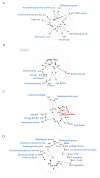Dietary-Lifestyle Patterns Associated with Adiposity and Metabolic Abnormalities in Adult Men under 40 Years Old: A Cross-Sectional Study (MeDiSH Project)
- PMID: 32178303
- PMCID: PMC7146269
- DOI: 10.3390/nu12030751
Dietary-Lifestyle Patterns Associated with Adiposity and Metabolic Abnormalities in Adult Men under 40 Years Old: A Cross-Sectional Study (MeDiSH Project)
Abstract
The aim of this study was to examine the associations of dietary-lifestyle patterns (DLPs) with adiposity and metabolic abnormalities in adult Polish men that were under 40. The cross-sectional study included 358 men that were 19-40-year-old. Dietary and lifestyle data were collected with multicomponent food frequency questionnaire (KomPAN®). DPLs were derived with Principal Component Analysis (PCA) using 25 dietary and six lifestyle as the input variables. Adiposity was determined with the use of: overweight (body mass index 25-29.9 kg/m2), central obesity (waist-to-height ratio ≥ 0.5), general obesity (body fat ≥ 25%), excessive visceral fat tissue (≥ median), and increased skeletal muscle mass (≥ median). The metabolic abnormalities were characterised by elevated: fasting blood glucose (FBG ≥ 100 mg/dL), triglycerides (TG ≥ 150 mg/dL), total cholesterol (TC ≥ 200 mg/dL), or systolic or diastolic blood pressure (≥ 130 or ≥ 85 mmHg, respectively). Four PCA-driven DLPs were derived and labelled accordingly to the most characteristic dietary or lifestyle behaviours that were correlated with each pattern. Multivariate logistic regression revealed that higher adherence (upper vs. bottom tertile as referent) to "Protein food, fried-food, and recreational physical activity" pattern was associated with higher odds of overweight and increased skeletal muscle mass, and lower odds of: general obesity, excessive visceral fat tissue, and elevated TC. Higher adherence to "Healthy diet, active, past smokers" pattern was associated with higher odds of overweight and lower odds of: general obesity, excessive visceral fat tissue, and elevated FBG. Higher adherence to "Sandwiches and convenient diet" pattern was associated with higher odds of: central obesity, general obesity, excessive visceral fat tissue, elevated TC, elevated TG, occurrence at least two metabolic abnormalities, and lower odds of increased skeletal muscle mass. A higher adherence to "Fast foods and stimulants" pattern was associated with higher odds of central obesity, general obesity, excessive visceral fat tissue, and lower odds of increased skeletal muscle mass. The interrelations between diet and lifestyle behaviours were reflected in three out of four patterns. Healthy diet attempts combined with active lifestyle was associated with reduced risk of adiposity and metabolic abnormalities despite some unhealthy components, like former smoking or fried-food consumption. In contrary, patterns that were composed of undesirable dietary behaviours solely, as well as poor diet combined with stimulant use, were associated with higher adiposity and worse metabolic health, despite the relatively young age of the study participants. Accurate mapping of dietary-lifestyle behaviours can serve as a tool for formulating evidence-based recommendations.
Keywords: adiposity; adults; dietary patterns; lifestyle; men; metabolic; principle component analysis; young adults.
Conflict of interest statement
The authors declare no conflict of interest.
Figures


Similar articles
-
Associations of Dietary-Lifestyle Patterns with Obesity and Metabolic Health: Two-Year Changes in MeDiSH® Study Cohort.Int J Environ Res Public Health. 2022 Oct 21;19(20):13647. doi: 10.3390/ijerph192013647. Int J Environ Res Public Health. 2022. PMID: 36294227 Free PMC article.
-
Prudent-Active and Fast-Food-Sedentary Dietary-Lifestyle Patterns: The Association with Adiposity, Nutrition Knowledge and Sociodemographic Factors in Polish Teenagers-The ABC of Healthy Eating Project.Nutrients. 2018 Dec 15;10(12):1988. doi: 10.3390/nu10121988. Nutrients. 2018. PMID: 30558296 Free PMC article.
-
Gender difference in the association of dietary patterns and metabolic parameters with obesity in young and middle-aged adults with dyslipidemia and abnormal fasting plasma glucose in Taiwan.Nutr J. 2019 Nov 16;18(1):75. doi: 10.1186/s12937-019-0503-x. Nutr J. 2019. PMID: 31733645 Free PMC article.
-
Offspring body size and metabolic profile - effects of lifestyle intervention in obese pregnant women.Dan Med J. 2014 Jul;61(7):B4893. Dan Med J. 2014. PMID: 25123127 Review.
-
[Simple obesity in children. A study on the role of nutritional factors].Med Wieku Rozwoj. 2006 Jan-Mar;10(1):3-191. Med Wieku Rozwoj. 2006. PMID: 16733288 Review. Polish.
Cited by
-
Advancing European nutrition - are pharmacists eligible partners in the process?Eur J Clin Nutr. 2021 Sep;75(9):1349-1358. doi: 10.1038/s41430-020-00846-6. Epub 2021 Feb 2. Eur J Clin Nutr. 2021. PMID: 33531633 Free PMC article.
-
Global burden of lung cancer attributable to metabolic and dietary risk factors: an overview of 3 decades and forecasted trends to 2036.Front Nutr. 2025 Mar 13;12:1534106. doi: 10.3389/fnut.2025.1534106. eCollection 2025. Front Nutr. 2025. PMID: 40181949 Free PMC article.
-
The Importance of Adverse Childhood Experiences in Depressive Symptoms and Their Biological Consequences in Healthy Adults: Results of a Polish University Student Study.J Clin Med. 2023 Nov 14;12(22):7093. doi: 10.3390/jcm12227093. J Clin Med. 2023. PMID: 38002705 Free PMC article.
-
Associations of Dietary-Lifestyle Patterns with Obesity and Metabolic Health: Two-Year Changes in MeDiSH® Study Cohort.Int J Environ Res Public Health. 2022 Oct 21;19(20):13647. doi: 10.3390/ijerph192013647. Int J Environ Res Public Health. 2022. PMID: 36294227 Free PMC article.
-
Lung Cancer Risk in Men and Compliance with the 2018 WCRF/AICR Cancer Prevention Recommendations.Nutrients. 2022 Oct 14;14(20):4295. doi: 10.3390/nu14204295. Nutrients. 2022. PMID: 36296978 Free PMC article.
References
-
- Nutrition Evidence Library . A Series of Systematic Reviews on the Relationship between Dietary Patterns and Health Outcomes. U.S. Department of Agriculture, Center for Nutrition Policy and Promotion; Alexandria, VA, USA: 2014.
-
- European Commission The State of Men’s Health in Europe: Extended Report, Luxembourg, European Commission. [(accessed on 5 March 2020)];2011 Available online: http://ec.europa.eu/health/population_groups/docs/men_health_extended_en....
-
- World Health Organization (WHO) Global Action Plan for the Prevention and Control of Noncommunicable Diseases 2013–2020. [(accessed on 5 March 2020)];2013 Available online: http://apps.who.int/iris/bitstream/10665/94384/1/9789241506236_eng.pdf.
Publication types
MeSH terms
Substances
Grants and funding
LinkOut - more resources
Full Text Sources
Medical
Miscellaneous

